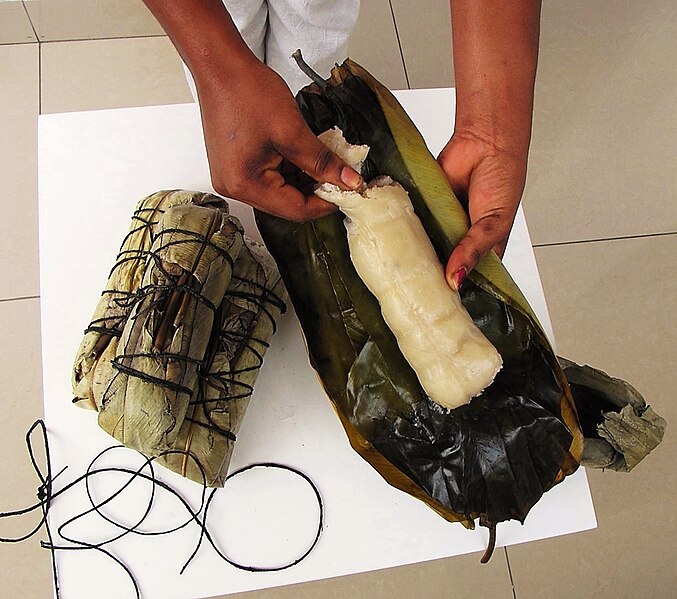File:Cassava Bread - cassava cooked in leaf wrap (Kwanga, Chikwangue).jpg
From Wikimedia Commons, the free media repository
Jump to navigation
Jump to search

Size of this preview: 677 × 599 pixels. Other resolutions: 271 × 240 pixels | 542 × 480 pixels | 924 × 818 pixels.
Original file (924 × 818 pixels, file size: 223 KB, MIME type: image/jpeg)
File information
Structured data
Captions
Captions
Add a one-line explanation of what this file represents
Summary
[edit]| DescriptionCassava Bread - cassava cooked in leaf wrap (Kwanga, Chikwangue).jpg |
English: A stack of fully-cooked, leaf-wrapped packets as sold on the street, also with the leaves unwrapped to show the ready-to-eat cassava 'bread.' If kept in the cooked leaf wrap, it is quite hygienic and will usually stay fresh for several days. Can be eaten as-is, but usually pinched off and dipped in any popular sauce. In the Congo (DRC) and central African region, often called kwanga or chikwangue, but also known by many names in the various languages across the region. Not actually a bread but a thick paste of soaked, rinsed and pounded cassava that is steamed-cooked inside leaves. Leaves also add a bit of tangy flavor during the cooking process. Six large leaves were used to tightly fold around and seal the roll of cassava before tied and cooked. Leaves shown from the plant Sarcophrynium arnoldium (Megaphrynium macrostachyum), alternately banana leaves can be used if these are not available.
Português: Uma pilha de pacotes embrulhados em folhas, totalmente cozidos, vendidos na rua, também com as folhas desembrulhadas para mostrar o 'pão' de mandioca pronto para comer. Se mantido no envoltório de folhas cozidas, é bastante higiênico e geralmente permanece fresco por vários dias. Pode ser comido no estado em que se encontra, mas geralmente retirado e mergulhado em qualquer molho popular. No Congo (RDC) e na região da África Central, costuma ser chamado de kwanga ou chikwangue, mas também conhecido por muitos nomes nas várias línguas da região. Não é realmente um pão, mas uma pasta espessa de mandioca embebida, enxaguada e amassada que é cozida no vapor dentro das folhas. As folhas também adicionam um pouco de sabor picante durante o processo de cozimento. Seis folhas grandes foram usadas para dobrar firmemente e selar o rolo de mandioca antes de amarrado e cozido. Folhas mostradas da planta Sarcophrynium arnoldium (Megaphrynium macrostachyum), alternativamente folhas de bananeira podem ser usadas se estas não estiverem disponíveis. |
| Date | |
| Source | Own work |
| Author | T.K. Naliaka |
Licensing
[edit]I, the copyright holder of this work, hereby publish it under the following license:
This file is licensed under the Creative Commons Attribution-Share Alike 4.0 International license.
- You are free:
- to share – to copy, distribute and transmit the work
- to remix – to adapt the work
- Under the following conditions:
- attribution – You must give appropriate credit, provide a link to the license, and indicate if changes were made. You may do so in any reasonable manner, but not in any way that suggests the licensor endorses you or your use.
- share alike – If you remix, transform, or build upon the material, you must distribute your contributions under the same or compatible license as the original.
File history
Click on a date/time to view the file as it appeared at that time.
| Date/Time | Thumbnail | Dimensions | User | Comment | |
|---|---|---|---|---|---|
| current | 21:45, 17 September 2015 |  | 924 × 818 (223 KB) | Piki-photow (talk | contribs) | User created page with UploadWizard |
You cannot overwrite this file.
File usage on Commons
The following 2 pages use this file:
File usage on other wikis
The following other wikis use this file:
- Usage on en.wikipedia.org
- Usage on en.wiktionary.org
- Usage on es.wikipedia.org
- Usage on fr.wikipedia.org
- Usage on it.wikipedia.org
- Usage on lt.wikipedia.org